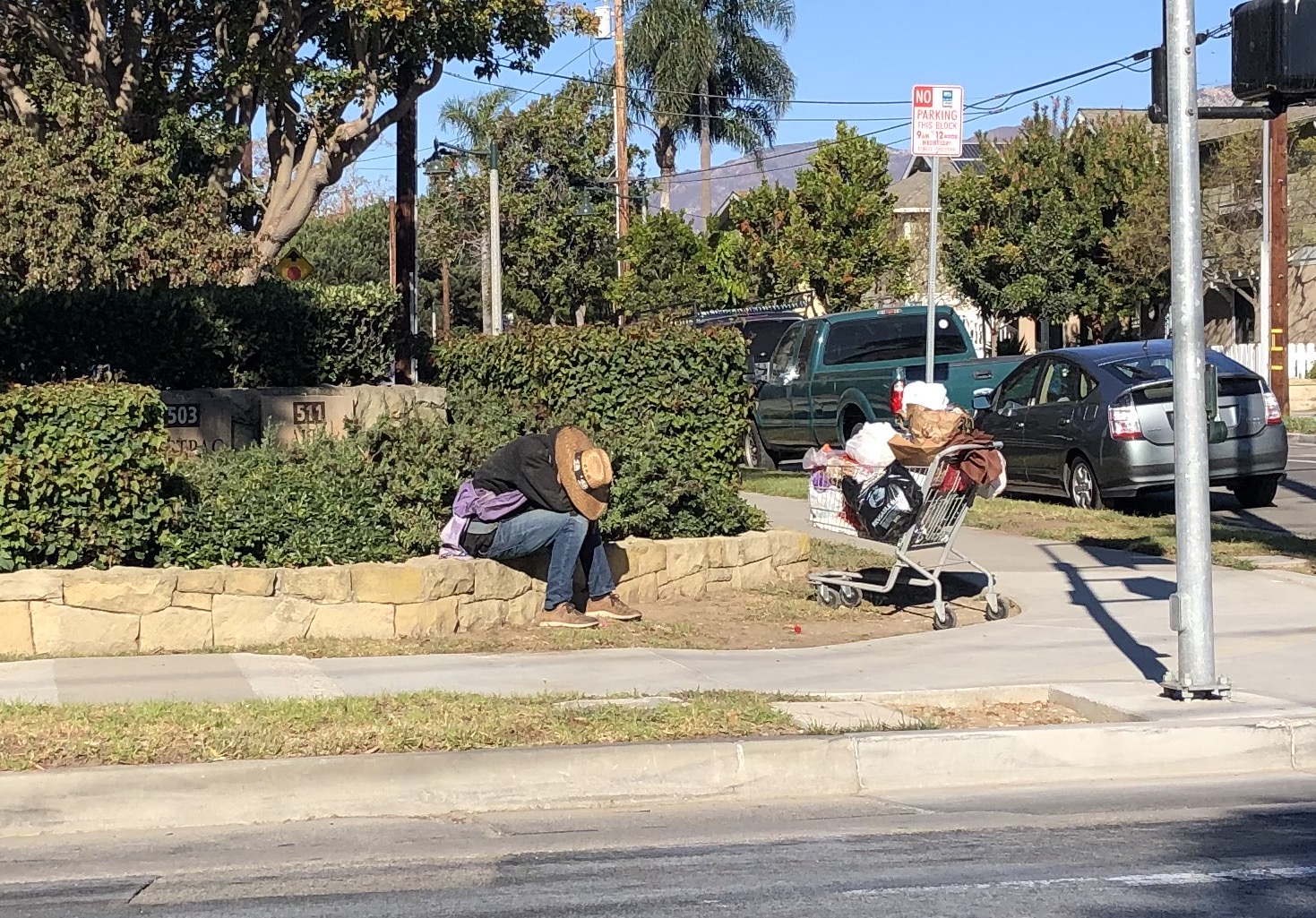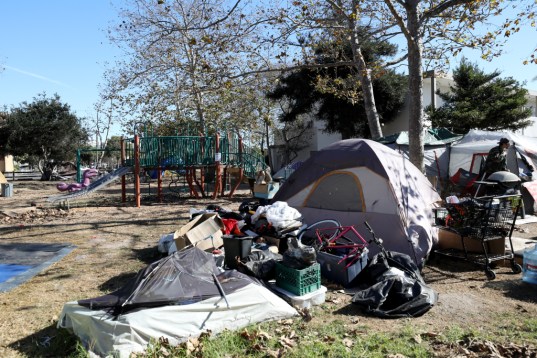Handling Homelessness During COVID
Pallet Homes Arriving, Pershing Park Getting Cleaned Up

The tent city in Isla Vista is only the most visible manifestation of the chronic problem in Santa Barbara County of people unable to find a place to live. It’s matched by the vans and cars parked at Pershing Park below City College, on which one of them is written: “Genocide of Homeless in Santa Barbara.” And any empathy most feel for the situation of homelessness is challenged by the fear of fire — most recently in the form of two big flareups along Highway 101 when a campfire under the trees “escaped” into the surrounding vegetation.
The quantity of people living “on the street” has become more of a visible issue during the coronavirus pandemic. The easy spread of the virus had the Centers for Disease Control strongly advising cities and counties to leave homeless camps in place. In Santa Barbara County, it is in out-of-the-way places under trees and behind bushes where many homeless people attempt to live. About 600 others are living in cars and vans, according to January’s Point-in-Time count of the homeless population, one-third more than in 2019.
In an attempt to limit pandemic clusters, California used $150 million from its federal CARES funding for Project Roomkey, which hired motel rooms in which to house the most vulnerable among the homeless population, or those at risk of catching a seriously bad case of COVID-19. In the City of Santa Barbara, not only did the program house dozens of people but their stable living situation enabled social services workers to find permanent housing for many of them.
The state’s next endeavor — Homekey — is to purchase permanent, supportive housing, and the County Housing Authority had been eyeing the Super 8 motel in Goleta as a possible site. That deal fell through, but the Housing Authority received nearly $3 million to purchase a former motel that had been turned into county offices in Lompoc. The county committed $1.5 million in matching CARES money for rehabilitating the structure, and supervisors are being asked to approve another $400,000 on Tuesday to complete the restoration of the bathrooms, subsidize the tenants’ rent through mid-2022, and continue mental-health services.
The 15 units include one for a site manager, and all the potential tenants for Homekey Studios are currently being served by homeless agencies in Lompoc. The last was a particular issue for Lompoc’s City Council when the motel conversion was discussed publicly, said John Polanskey of the county’s Housing Authority. “We gave notice to the community and to the City Council,” he said, “and the reception was good, although the council was concerned that the people we housed were already living in Lompoc.” All the people being interviewed were already clients of the county’s Behavioral Wellness department, which had previously used the converted motel as office space, or of other shelter services in Lompoc.
Kimberlee Albers, the county’s homeless programs manager, affirmed that a key part of the work has been to choose tenants who have been in the community for a long time. In Isla Vista, a community of small homes — 8×8-foot prefab structures made by Pallet — will be assembled in the parking lot of the I.V. Community Center next week. “We don’t want people to think that Isla Vista is the place to go,” she said in discussing the new structures. Outreach workers had counted about 44 homeless people in Isla Vista in June, a number that had grown to about 80 by November.
Get the top stories in your inbox by signing up for our daily newsletter, Indy Today.
The tent cities that had grown in four of I.V.’s parks over the summer flummoxed the Isla Vista Recreation and Park District, which owns the Community Center’s parking lot. At three of the parks, the tents were pitched near homes or fences, and the county fire marshal declared them a fire hazard in early November, after which they were summarily removed. Before that, however, workers from City Net, Behavioral Wellness, Home for Good, Public Health, and other groups visited the tent cities and persuaded about a dozen residents to move to “safer locations,” Albers said.

Some of them migrated to Anisq’Oyo’ Park in the college town’s center, which now has about 30 tents right next door to the Community Center parking lot. The hope is that permanent housing can be found for some people during the Pallet town’s six-month run in the parking lot, and as many as 50 people are anticipated to live there over time. A North County homeless shelter operator, Good Samaritan, will provide services out of the Community Center, and portable showers and bathrooms will be placed onsite. The roughly $1 million cost for the program comes ultimately from CARES Act money, through the state to the county, some of which is earmarked for emergency shelter during coronavirus.
It is unknown if these two statistics are related, but Isla Vista’s apparent increase in homeless numbers coincided with fewer homeless people contacted by City Net in the City of Santa Barbara between June and September. The homeless outreach group only surveyed the waterfront, Milpas, and State Street areas, but they found a net drop of 25 percent — from 452 individuals in June to 340 in September — in the limited count.
Far more apparent have been the fires inadvertently begun along the 101 near homeless camps. The most recent on Thanksgiving weekend saw the Humane Society off Patterson Avenue removing its animals to Santa Maria and some residents of Maravilla voluntarily evacuating until the two fires were put out. That was the seventh homeless-related “escaped fire” in the South County since the first coronavirus patient was identified in mid-March, said County Fire Marshal Rob Hazard. The Summerland-Carpinteria area has had about five such incidents, the district’s Fire Marshal Rob Rappaport said. And Santa Barbara City Fire Marshal Joe Poiré estimated the number of homeless fire calls had gone up. Though the city didn’t collect such statistics currently, it was likely they’d start next summer, Poiré said.
Campfires at Pershing Park below City College had been an issue early in the pandemic, said a parks worker, but they aren’t any longer. The department had received many complaints from neighbors, said Parks Manager Matthew Parker, and notices had been given earlier this week to the people living in tents, cars, and vans to leave by December 7 so parks workers could clean up the accumulated trash and debris. One car parked at the lot, a late-model BMW, was surrounded by trash bags. Once the work is completed, it is likely they will return, Parker acknowledged.
If they come back to Pershing, however, new signs will be up that limit vehicles to 72 hours of parking. Any vehicle over 24 feet long, two of which had been overstaying their welcome, said Parker, will not be allowed in the lot. As well, a new gate will be installed in the driveway to block access overnight, a gate either City College or the parks department would control. The trees along the driveway — under which about four tents are pitched currently — will be pruned as part of the general maintenance Parker said will take place next week.
Every day, the staff of the Santa Barbara Independent works hard to sort out truth from rumor and keep you informed of what’s happening across the entire Santa Barbara community. Now there’s a way to directly enable these efforts. Support the Independent by making a direct contribution or with a subscription to Indy+.




You must be logged in to post a comment.